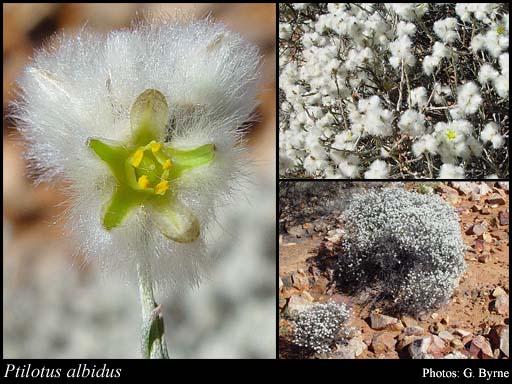- Reference
- Mitt.Bot.Staatssamml.München 4:277 (1962)
- Conservation Code
- Not threatened
- Naturalised Status
- Native to Western Australia
- Name Status
- Current
Compact, perennial shrub, 0.2-0.6 m high, leaves, grey-green, linear, 3-14 mm long, 1-2 mm; spikes orbicular, white, 10-22 mm long, 10-16 mm wide, 7-10 flowered; tepals 5-8 mm long, apex, entire, hooded, indumentum woolly, hairs septate; stamens 5, fertile; ovary glabrous; style straight, 2.6-3 mm long. Fl. white, May to Nov. Stony soils, sometimes saline. Breakaways, clay plains.

Scientific Description
Shrubs, stems single, more or less erect, persistently hairy or glabrescent, with nodose hairs. Leaves present, 3-14 mm long, 1-2 mm wide, persistently hairy, with nodose hairs; basal rosette absent; cauline leaves alternate. Spikes white, ovoid or spherical, solitary, with densely arranged flowers. Bracts 1.5-2.5 mm long, coloured, hairy, not awned or mucronate, with an obscure midrib. Bracteoles 3.3-4.5 mm long, coloured, hairy, not awned or mucronate, with an obscure midrib. Outer tepals 6.8-9.5 mm long, entire. Inner tepals 6.3-9 mm long, glabrous within. Style 2.6-3 mm long, straight, centrally fixed to ovary. Seeds (2.1-)2.2-2.4(-2.5) mm long, dull, brown. Distribution: Eremaean Botanical Region; IBRA regions: Gascoyne, Little Sandy Desert, Murchison.
Distribution
- IBRA Regions
- Gascoyne, Little Sandy Desert, Murchison.
- IBRA Subregions
- Augustus, Carnegie, Eastern Murchison, Trainor, Western Murchison.
- Local Government Areas (LGAs)
- Meekatharra, Sandstone, Wiluna.